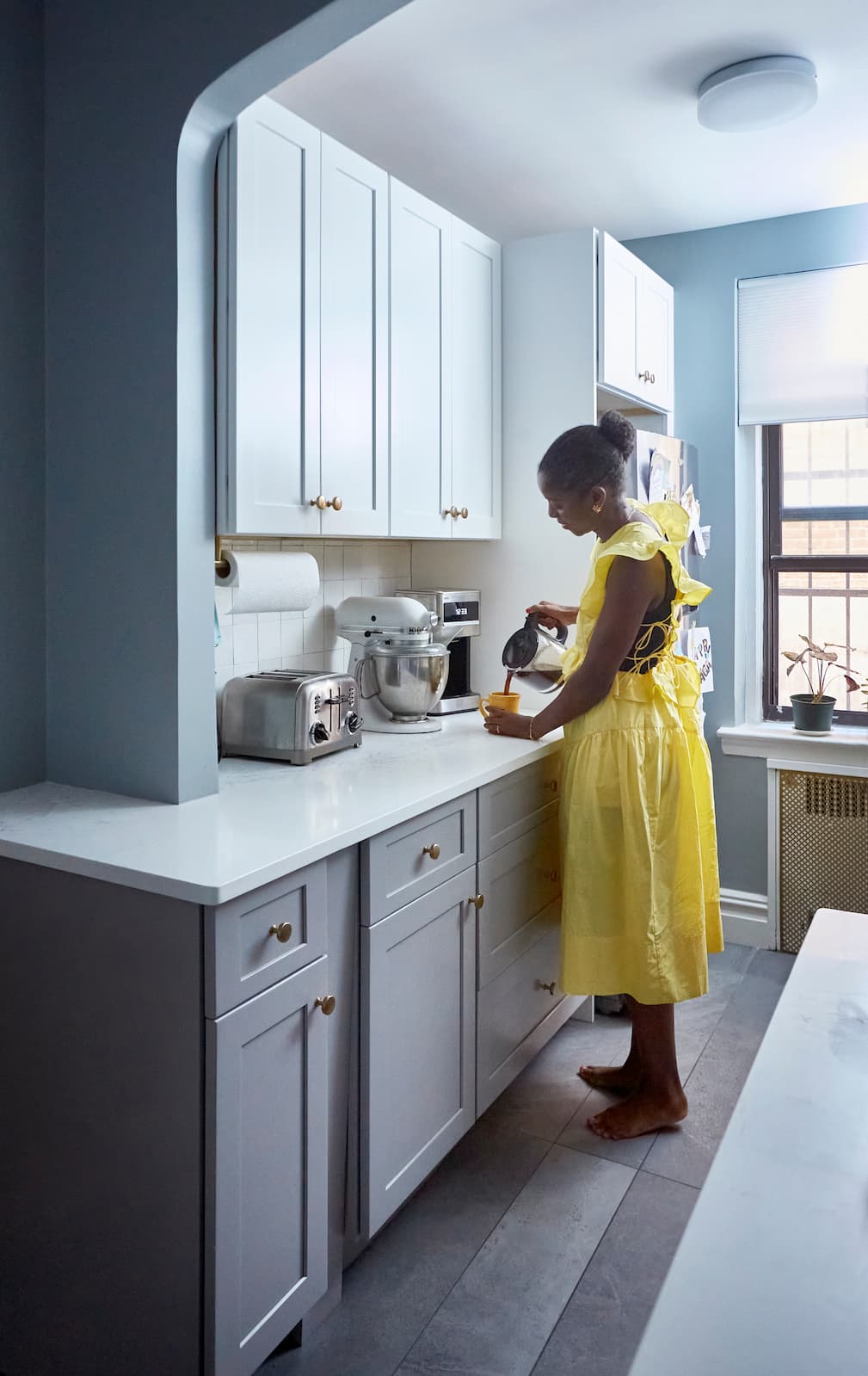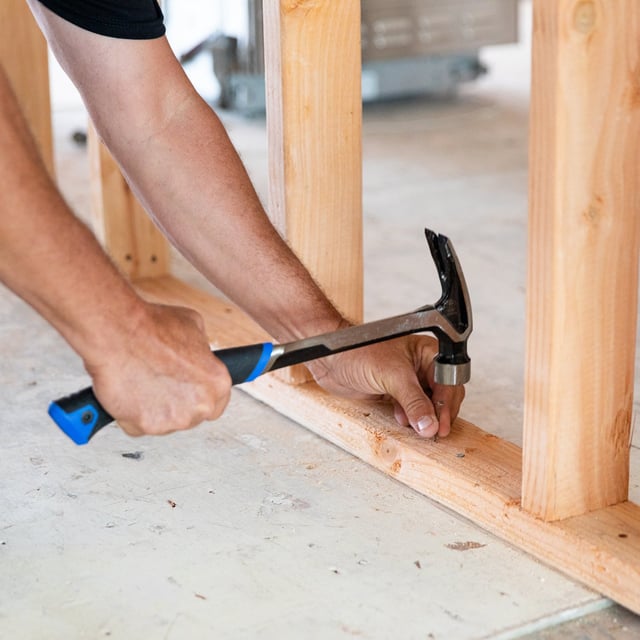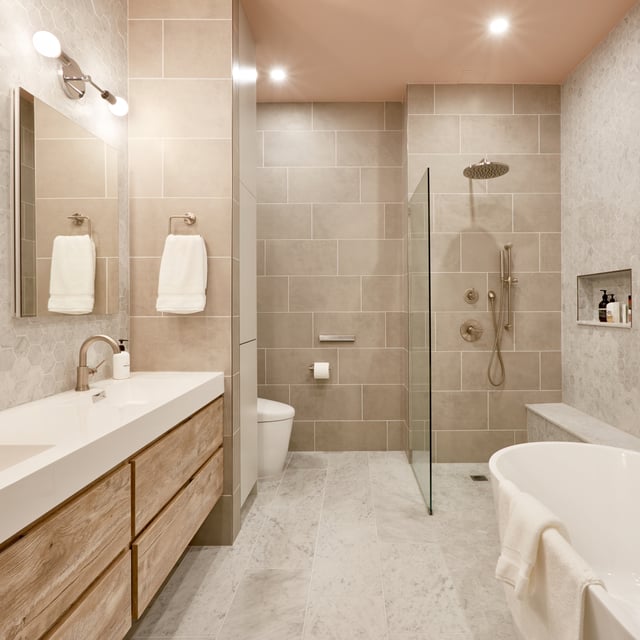
Paint & Color
Gray Floors? Here's What Paint Colors Will Flatter Your Walls
12.06.2025
Our New Year savings event is here: Get up to $6,500 off your project today (terms apply).


In This Article
Planning to paint your home? It’s a good idea to know what to expect before you get started. On average, painting the interior of a house costs between $1,000 and $7,000, same exterior painting ranges from $1,000 to $4,000 per 1,000 square feet. These numbers can vary depending on things like the size of your home, the condition of the walls, and the type of paint you choose.
For interior painting, factors like how many rooms you’re painting, ceilings and trim are included or not, and how much prep work is needed will all affect the cost. Exterior painting is a bit more involved, with things like surface type, the number of stories, and extra prep work like sanding or repairs coming into play. Labor is the biggest expense, and paint quality matters too; investing in good paint can save you money in the long run.
This guide will walk you through everything you need to know about painting costs, helping you plan your project with confidence. Whether it’s a single room or your whole house, you’ll feel ready to tackle the project and get one step closer to your finished space!
The cost of painting a home’s interior is typically calculated based on square footage and the specific rooms being painted. On average, interior painting costs $1 to $3 per square foot, depending on factors like the type of paint used, labor rates in your area, and any prep work required. This range can increase if you’re including ceilings, trims, or accent walls in the project.
Here’s a room-by-room breakdown to give you an idea of what to expect:
For additional tips on choosing paint for specific rooms like bathrooms, check out this guide on selecting paint for bathrooms.
Interior painting costs depend on a range of factors that influence both material and labor expenses. These elements can help you set realistic expectations and make informed decisions for your project. Below are the key factors, explained in detail.
If the walls are in good shape, the project will likely require minimal prep work, keeping costs lower. On the other hand, walls with damage such as cracks, holes, or peeling paint need repairs before any paint can be applied. This additional labor increases both time and expense.
Tip: Skimping on prep work may lead to an unprofessional finish and reduce the lifespan of your new paint job, making it worth the investment upfront.
The type and finish of paint directly affect the cost of your project. Each type has its purpose and price point, and selecting the right one depends on the specific room and its usage.
Tip: Premium paints with better durability and coverage have a higher upfront cost, they save money in the long run by requiring fewer coats and lasting longer.
For advice on selecting the right paint finish for your bathroom, see this guide on bathroom paint finish options.
The number of coats required for your project impacts both labor and material costs. Projects that involve switching from a dark color to a light one or vice versa require additional coats for complete coverage.
Key Considerations
Tip: Choosing a paint with better pigmentation can reduce the total number of coats and save on labor.
Including ceilings and trim work significantly impacts the overall cost due to the level of precision required. Ceilings may need special paints that resist stains or have low glare, while trims like crown molding and baseboards require careful attention to detail.
By considering these factors wall condition, paint type, number of coats, and inclusion of ceilings and trim you can better estimate your interior painting budget and plan your project efficiently.
As we discussed above in the Cost-Saving Tips for Interior Painting, managing your budget is key. But it’s equally important to account for additional costs that can impact the final price of your project. These costs may not always be obvious but can make a big difference, especially if your project includes custom touches or specific preparation needs.
Adding custom features like accent walls or murals can elevate the look of your space but also increase your expenses.
If you’re planning to include custom features, it’s best to discuss these with your contractor upfront for an accurate estimate.
Preparing your space for painting is an important step and can incur additional costs, especially if you rely on professionals to handle it.
To save on these expenses, you can clear furniture yourself and purchase affordable coverings from a local hardware store.
Exterior painting involves unique challenges and costs, which vary based on the size of your home, the materials used, and additional requirements like surface preparation and weatherproofing.
For most homes, this ranges from $1 to $6 per square foot, depending on the complexity of the job, labor rates, and paint quality.
Factors like location and local labor rates also influence the total cost. For an accurate estimate, measure the exterior surface area of your home and consult with professional painters to understand what your specific project entails.
Several factors can affect the cost of painting your home’s exterior. These include the type of surface, the condition of the exterior, and special requirements for weatherproofing.
Homes with peeling paint, cracks, or damage require extra prep work. Scraping, repairing, and priming the surface can add $500 to $1,500 to the total cost. This step is essential for a smooth and long-lasting finish.
Applying weather-resistant paint is important for areas exposed to harsh climates. This type of paint is typically more expensive but offers protection against moisture, UV rays, and temperature changes.
Multi-story homes require additional equipment like ladders or scaffolding, increasing labor time and costs. If your home has architectural features that are difficult to access, expect to pay a premium.
Exterior painting projects come with add-ons that can shine the overall look of your home but also raise the budget.
Cleaning the exterior before painting is a crucial step to remove dirt, mildew, and debris, ensuring better paint adhesion.
Pressure washing typically ranges from $150 to $300, depending on the size of your home and the amount of buildup.If you’re painting additional structures like decks, fences, or detached garages, these will add to your total cost:
Painting exterior windows and doors is time-consuming and requires precision. Costs for these features depend on their number and design:
Proper planning for these factors and additional costs ensures your exterior painting project stays on track and delivers lasting results.
In any painting project, choosing between DIY and hiring professionals is one of the most important decisions you'll make. Both approaches come with unique costs, time commitments, and challenges. Below is an in-depth breakdown of what to expect from each option to help you decide which one best fits your needs.
DIY painting can be cost-effective for smaller projects, but it’s not as straightforward as it seems. You save on labor costs, you’ll need to factor in the materials, time investment, and your skill level to achieve quality results.
To complete a DIY project, you’ll need several supplies:
For a medium-sized room (10x12 feet), DIY material costs can range from $200 to $500, while an exterior project may require an investment of $600–$1,000 in materials alone.
DIY is ideal for those with experience or for small-scale projects. For beginners, mistakes like uneven coats, drips, or poor edge work may lead to higher material costs and additional time for corrections.
Hiring professionals ensures a polished, high-quality finish but comes with higher upfront costs. The total expense varies based on labor rates, project size, and complexity.
Professional painters charge by the hour or square foot:
For example:
|
Factor
|
DIY
|
Professional |
|
Cost
|
$200–$1,000 (materials only)
|
$300–$10,000 (labor + materials)
|
|
Time Investment
|
High (days or weeks)
|
Low (hours to days)
|
|
Quality
|
Dependent on skill level
|
Consistently high
|
|
Tools and Equipment
|
Must be purchased or rented
|
Provided by painters
|
|
Safety
|
Riskier without proper equipment
|
Managed by professionals
|
|
Long-Term Durability
|
Varies based on application quality
|
Usually guaranteed
|
After weighing the pros and cons of DIY and professional painting, Next step how to make your project more cost-effective. Painting can be a significant investment, there are practical ways to cut expenses without sacrificing quality.
While high-end paints offer durability and superior finish, there are budget-friendly options that perform well, especially for less demanding areas.
For areas like kitchens or bathrooms, prioritize quality over price by selecting paints with moisture resistance or easy-clean properties. These specialty paints cost more upfront but reduce maintenance costs down the road.
Combining interior and exterior painting projects into one contract can lead to significant savings. Painters can optimize labor and materials when handling multiple projects simultaneously, reducing overall costs.
While bundling increases the upfront expense, it minimizes long-term repainting costs and ensures a cohesive look throughout your home.
Timing your project strategically can lead to significant cost reductions. Painters are busiest during spring and summer due to ideal weather conditions. Scheduling your project during the off-season—fall or winter for most regions—can result in lower labor costs and access to promotions.
Check with local contractors to learn about seasonal pricing adjustments or package deals.
Preparation accounts for a significant portion of painting costs, especially when hiring professionals. Handling some or all of the prep work yourself can save hundreds of dollars.
While these tasks are manageable for most homeowners, leave major repairs or sanding large surfaces to professionals to ensure quality results.
Beyond reducing costs, it’s important to think about factors that impact the longevity of your paint job and your long-term expenses.
Knowing when to repaint helps avoid unnecessary costs and ensures your home stays in great shape.
Tracking the age of your paint job and scheduling regular inspections can prevent costly repairs caused by neglect.
The climate in your region plays a major role in the durability of exterior paint.
Your local environment allows you to choose the right paint and maintenance schedule, saving costs in the long term.
While budget paints may seem appealing, they lead to more frequent touch-ups or repainting. High-quality paints provide better coverage, require fewer coats, and resist wear and tear for longer.
Investing in quality paints may increase upfront costs but offers savings through reduced maintenance and longer-lasting results.
Painting your home involves balancing costs, quality, and maintenance. By choosing the right materials, bundling projects, and timing your work strategically, you can achieve great results without overspending.

Written by Block Renovation
What factors affect the cost of painting a house interior?
How often should you repaint the exterior of your house?
What is the average cost of painting a single room?
Can painting the house increase its resale value?
What are the pros and cons of DIY house painting?

Renovate confidently with Block
Easily compare quotes from top quality contractors, and get peace of mind with warranty & price protections.
Thousands of homeowners have renovated with Block

4.5 Stars (100+)

4.7 Stars (100+)

4.5 Stars (75+)

Paint & Color
Gray Floors? Here's What Paint Colors Will Flatter Your Walls
12.06.2025

Cost
How Much Does a Bathroom Addition Cost?
09.26.2025

Cost
Calculating the Cost of Your 12x24 Addition
09.18.2025

Cost
10x10 Bathroom Remodeling Costs
09.18.2025

Cost
The Average Cost of a Jacuzzi Bath Remodel—and How to Save
09.18.2025
Renovate confidently